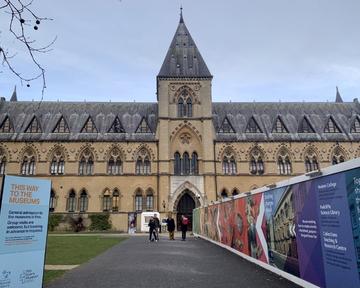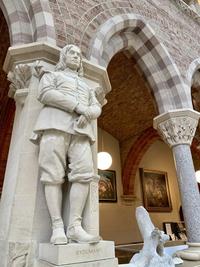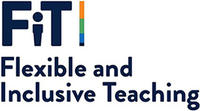Oxford integrates the ‘New Educational Curriculum’ of the 2026-2030 period
Read Olivia Farrar's highly commended submission
In Hilary term 2022, students at all levels of study at Oxford were invited to enter the Imagining the Future of Digital Education writing competition.
Entrants submitted news articles telling fictitious stories of the future of digital learning at Oxford, with all submissions helping to inform the University’s new Digital Education Strategy.
Olivia Farrar's entry was highly commended by the judging panel. Here is her submission. You can also view all competition winners.
Oxford integrates the ‘New Educational Curriculum’ of the 2026-2030 period
17 March 2026
The scene is different today outside Oxford colleges
Rather than flocking into the halls laden-down with backpacks full of binders and notebooks, the students across Oxford have come to their classrooms empty-handed. Instead of sitting at small desks and staring out towards a blackboard, receiving rote knowledge, hundreds within groups are resting in peaceful circles with their eyes closed.
As Pro-Vice-Chancellor of Educational Change at the Centre for Educational Assessment Professor Gabriella Lee, Oriel College, announced at the beginning of the new year, all Oxford colleges have made the full transition into the ‘New Educational Curriculum’ of the 2026-2030 period.
Alongside altered attendance times and basic structural changes like frequent exercise and wellbeing breaks (defined however the students see best, including alone time in the school’s newly constructed ‘personal space’ zones, time in the gardens, or periods spent producing crafts and other art), all Oxford University undergraduate and graduate programs have embraced the nationwide ‘Digital Technologies Curriculum to the 2030s’ initiative.
The major thrusts of the digital integration movement include, broadly, the assimilation of artificial intelligence (AI) technologies, learning analytics, predictive analytics, adaptive learning software, learning management systems (LMS), and extended cloud platform software. As per the University-wide changes, no college is to be without these and other ‘superintelligent’ branded technologies by the late 2020s.
At the level of the student, these changes look very specific.
We followed Professor Nigel Hamlin, course head of Religion and Oriental Studies and participating member of the Chair of the Oxford Education Committee, as he spent a class with his students.

At 10, after breakfast and morning activities, students in all programs are led into their respective Faculty offices’ ‘Reflection Room.’ To balance the effects of digital immersion and integration, they are provided with 30-40 minutes of guided or personal meditation. In Hamlin’s words, the meditation “Keeps them grounded and internal, as the world around becomes increasingly depersonalized.”
Following the morning rituals, Oxford students are given individualized tablets for the day and sent into small-group rooms to work alongside 3-4 peers with their respective interfaces. Professors usually lead a short introductory lecture or discussion prior to the dispensation of the tablets – these lectures are generally capped in time to under forty-five minutes, to keep the quality of the conversation and presentation flowing. Each tablet has a corresponding lesson plan downloaded onto it, which is algorithmically coded to be flexible enough to adapt to the needs of the student.
“After all,” Professor Hamlin explained, “The most effective form of learning comes from active, rather than passive, engagement. Since we want our students to optimize information retention, this means that every single student within a classroom should have a pre-tailored and individualized curriculum, characteristic of their individual needs and wants.”
Such personalization, of course, would be way out of the range of possibility for one Professor (even an Oxford don). Yet, with tablet interfaces that lecturers and tutors can use to embed YouTube videos, curriculum, and flashcards, students are presented with exactly what they need to know at exactly the time that works best for them.
Quite the system – and the cherry on top, as Professor Hamlin explained animatedly, comes from the gamification options. “Learning is, basically, specified and directed knowledge play,” said Nigel. “The curriculum builds on this.”
Even with the level of flexibility offered by the E-Class tablets, however, they are still tools for the accumulation of concretized and rote knowledge. Creativity, perhaps the most difficult thing to pin down and to teach generally, is encouraged digitally with ClassVR headsets – ‘standalone’ virtual reality headsets, which are each complete with a unique student-friendly interface, gesture controls, embedded educational resources, and simple-to-use teacher controls.
We watched as Puja-Arti, an undergraduate reading in Sanskrit and studying the history of early Judaic mysticism, put one on. His face seemed to light up before us, and we could only imagine the worlds he was being dropped into.
From formative through lifelong education, learning happens as a result of experience. Of course, experience is expensive: while a student might learn best about the Mayan civilization on a field trip to the lowlands of Guatemala, a foreign language like Dutch in a pseudo-simulation of a café in Amsterdam, or particle physics on a tour of CERN, such experiences would be well beyond the range of any single institution’s capabilities.
The ClassVR headsets place students into immersive 360 environments, which are used to enhance and complement real-world exploration, play, and knowledge. In these environments, students engage in citizen science projects, work independently with AI-driven technologies, collaborate in international teams, and use 3D graphics and virtual reality/augmented reality (VR/AR) to experience new dimensions of curriculum content that they are expected to learn.
“In addition to the immersion,” Professor Hamlin told us, “The headsets are wired with generative AI algorithms, which allow for personalized lesson plans.”
In this environment, the role of the educator becomes more exciting – here, it is about telling the students why they’re learning, rather than just providing material tacitly. That way, students can link information to things they actually care about, and begin applying new concepts to projects immediately.
Chancellor Lee argues that the new curriculum offers opportunities for students to become efficient, autonomous, team-working, and creative problem solvers.
Dr. Gail Martin, Chair of the Graduate Committee of the Conference of Colleges and participating member of the Education Committee, agreed about the importance of making learning “more personal to each learner.”
“These tools are meant to make students active and engaged in the real world, not only to turn them into ‘digital nomads’ seeking freedom, individualism, and aesthetic joy outside the confines of a traditional classroom.”
One of the tide-changes of COVID-19 in the education sector has been a renewed sense of freedom in learning – independence which hasn’t been seen since before the Industrial Revolution in most parts of the world, and the mechanization of education into highly-structured schooling bodies. Digital tools have liberated the average student to pursue more personal interests, not completely tethered to the controlling impulses of academic curricula, environments, or expectations.

After all, physical universities require an amount of homogenization in order to maintain routine operation. Testing and examination is a crucial part of this.
By structuring education around the grade and the impetus to look to the future and consider the applicability of what one is learning now for the job market ahead, young people are learning what it means to get things done, not learning what it means to create a life for themselves and others.
“The self-reliance allowed by digitally-directed immersion can help to circumvent this ‘teaching to the test’ standardization,” explained Dr. Martin. “That being said, there is a fine balance between isolating students as itinerant faces behind screens, and using those screens as ways of accessing a larger educational and social whole. Besides – who would want to be a bubble on Microsoft Teams forever, in a place like this?”
As a world-renowned establishment, Oxford University stands second to almost none in terms of the opportunities it presents students. It also imposes a tremendous amount of pressure, which digitization could reduce.
Some doomsdayers herald the digital revolution as fundamentally and irrevocably reshaping the nature of reality for the worse. The claims suggest, broadly, that digital tools dehumanize educational environments, deteriorate students' reading and writing competencies, distort social interactions between teachers and students, and isolate individuals.
Yet, the ‘Digital Technologies Curriculum to the 2030s’ initiative works to use the inevitability of virtual-hybrid reality for good.
As the morning gradually turned into afternoon across the Oxford campus, and undergraduates, graduates, professionals, and tourists alike milled the cobbled streets and steepled halls, a change could be felt in the air.
The ‘Digital Technologies Curriculum to the 2030s’ initiative hopes to usher in a new era of adaptability, creativity, and happiness for students at Oxford University – as not only the next generation of changemakers within a volatile world, but as dreamers and human beings.

Contact us
If you have a query, please contact us at
Stay informed


